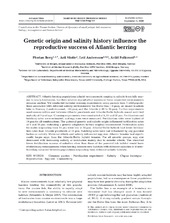| dc.contributor.author | Berg, Florian | |
| dc.contributor.author | Slotte, Aril | |
| dc.contributor.author | Andersson, Leif | |
| dc.contributor.author | Folkvord, Arild | |
| dc.date.accessioned | 2019-04-29T09:31:24Z | |
| dc.date.available | 2019-04-29T09:31:24Z | |
| dc.date.issued | 2018 | |
| dc.Published | Berg F, Slotte A, Andersson L, Folkvord A. Genetic origin and salinity history influence the reproductive success of Atlantic herring. Marine Ecology Progress Series. 2018 | eng |
| dc.identifier.issn | 0171-8630 | en_US |
| dc.identifier.issn | 1616-1599 | en_US |
| dc.identifier.uri | http://hdl.handle.net/1956/19429 | |
| dc.description.abstract | Atlantic herring populations inhabit environments ranging in salinity from fully marine to nearly freshwater, but their relative reproductive success in these respective environments remains unclear. We conducted factorial crossing experiments using parents from 3 wild populations associated with different salinity environments: the Baltic Sea (~6 psu), an inland brackish lake in Norway (Landvikvannet, ~16 psu), and the Atlantic (~30 to 35 psu). Further experiments used crosses within and between Atlantic purebreds and Atlantic/Baltic hybrids reared until first maturity at 3 yr of age. Crossing experiments were conducted at 6, 16 and 35 psu. Fertilization and hatching rates were estimated, and egg sizes were measured. Fertilization rates were highest at 16 psu for all combinations. The paternal genetic and salinity origin influenced fertilization rates at 6 and 35 psu, indicating a genetic adaptation to their original environment. Fertilization rates for males originating from 16 psu were low at 35 psu. Atlantic/Baltic hybrids had lower fertilization rates than Atlantic purebreds at 35 psu. Hatching rates were not influenced by any parental factors or salinity. Maternal effects and salinity influenced egg size. Atlantic females had significantly larger eggs than the Atlantic/Baltic hybrid females. For all genetic groups, egg size decreased with increasing salinity at incubation mainly due to osmotic effects. The observed lower fertilization success at salinities other than those of the parental fish habitat would have evolutionary consequences when herring colonize new habitats with different salinities or if interbreeding occurred between populations originating from different salinity habitats. | en_US |
| dc.language.iso | eng | eng |
| dc.publisher | Inter-Research | en_US |
| dc.rights | Attribution CC BY | eng |
| dc.rights.uri | http://creativecommons.org/licenses/by/4.0 | eng |
| dc.subject | Common-garden | eng |
| dc.subject | Fertilization experiment | eng |
| dc.subject | Salinity | eng |
| dc.subject | Clupea harengus | eng |
| dc.subject | Reproduction | eng |
| dc.subject | Egg size | eng |
| dc.subject | Connectivity | eng |
| dc.title | Genetic origin and salinity history influence the reproductive success of Atlantic herring | en_US |
| dc.type | Peer reviewed | |
| dc.type | Journal article | |
| dc.date.updated | 2018-09-25T06:26:50Z | |
| dc.description.version | publishedVersion | en_US |
| dc.rights.holder | Copyright 2018 The Author(s) | en_US |
| dc.identifier.doi | https://doi.org/10.3354/meps12680 | |
| dc.identifier.cristin | 1613171 | |
| dc.source.journal | Marine Ecology Progress Series | |

